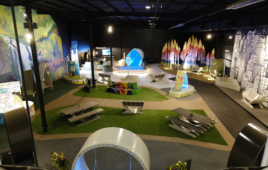The engineering world runs on specialized software. Simulation software spans a range of capabilities in the wind industry. For instance, specialized packages help gearbox engineers assemble and test the bearings and gearing that will handle up to 5 MW of wind-generated torque. General purpose finite-element analysis does a fair job of finding stresses in relatively static structures. Newly emerging software is letting structural engineers better understand how composites are best used to build the elusive 100-m blade. Computational fluid dynamics (CFD) helps blade engineers see how a new aerodynamic surface will perform in particular locations. Versions of it are also letting project planners see how wind swirls and flows over the terrain of a proposed wind farm. And lastly, proprietary versions of software are used to make a better wind and weather forecast. Because most software is proprietary, this discussion touches on the commercially available packages.
Gearbox design
One version out of the U.K. and supported by offices in the U.S. combines CAD features with analysis of wind turbine gearboxes, bearings, and drivetrains. The developer says the software can simultaneously model and analyze bearing deflection, shaft misalignment, spline deflection, gear-mesh misalignment, and housing deflection. Features include drivetrain and gearbox modeling including shafts along with mass and inertial of rotor blades when necessary. Even press fits and clearances are considered in simulation. Of course, the software generates detailed 3D representations of the gearbox.
CFD
This fluid-flow software traditionally assisted with the aircraft design. But recent trends are toward a wide range of specialized and focused simulation applications that assist with tasks such as composite blade optimization, and dynamic studies of blade and tower assemblies. The wind industry has also encouraged development of software for detailed rotor aerodynamics, wake predictions, and vortex-induced vibration from offshore platforms along with vortex-induced motion.
“Multi-physics simulations are an emerging capability within computational fluid dynamics,” says Acusim Senior Analyst David Corson. “Historically, CFD software focused on predicting fluid and thermal transport. Recent advances let us include additional physics into the simulation flow field. One area with significant implication for wind-turbine design is Fluid-Structure Interaction.” For instance, as turbine blades are designed longer and use new materials, deflection under wind load becomes increasingly important. In high wind, for instance, a blade could deflect enough to hit the tower. But will it? This software can give a good indication. Turbine designers must also consider how a blade’s aerodynamic performance changes with deflection, and fatigue concerns arising from blade deflections.
A few finite-element based CFD solvers contain two techniques for simulating such behavior in wind turbines. Wind loading on blades (the fluid and structure) provides excitation of various vibration modes of the blades, and the resulting deformation is the sum of each modal contribution. All fluid and structural computations are performed by the CFD solver, so there is no run-time coupling of the solver to external codes. A second technique works well for larger (nonlinear) bending applications. The software supports run-time coupling to external structural dynamics codes often using Directly Coupled Fluid-Structure Interaction methods. “This lets users couple the software to a preferred structural solver, and requires no intervening middle ware for the coupling,” says Corson. The solver software handles the interpolation between dissimilar meshes (between structural model and fluid model) and communication requirements. A few such programs of this sort allow running structural and CFD codes on various computers using different operating systems.
Offshore wind turbines prompt additional questions because they sit on towers driven deep into the ocean floor. “Strong currents can produce Vortex-Induced Vibration and Motion off risers and platforms. This leads to fatigue damage or sea bed erosion,” says Altair Software spokesperson Shing Pan. “Experience with offshore oil platforms lets software such as AcuSolve provides validated solutions in this area to help predict tower stresses from wave motion and vortex action. The software helps optimize designs by taking into account changes in current speed and direction that often vary with depth.”
Simulation software has been developed to analyze a wide range of effects, such as wave motion, multiple structures, riser shapes, and motions including nonlinear response. What’s more, the software can tell of interactions with sea bottom and other complex problems, and transient turbulent processes including boundary layer phenomena, separation, and free shear of wakes.
Other areas in which CFD provides insight include the aerodynamics of steady, transient, and moving rotors. Also, CFD is useful in siting studies that allow examining macro, micro, and wake predictions. Just as important are noise predictions from high-resolution transient simulations. Software can also assist with the best practices and the design of experiments.
Designing wind farms
Software for designing the layout of wind farms is also experiencing frequent upgrades. Commercially available programs allow inputting information such as terrain models, historic wind data, performance graphs of selected turbines, and location identifiers. The software then considers wake effects and wind probabilities to calculate annual wind power outputs from each turbine and the entire farm. Adjusting locations allows finding a layout with the maximum payout.
A closer look at wind flows
Researchers now recognize that one or two met masts do not sample sufficient complexity in the wind for accurate calculation. They propose flow models that include detailed conditions such as turbulence, wind shear, and vortex shedding that causes sudden changes to wind direction. At least one version has come out of the lab.
A first step assesses terrain complexity. Although the use of ruggedness-index values can help assess complex terrain, it is not always readily available to investors or developers and does not take in to account the effect of land cover on flow complexity. In response, Natural Power has developed a complexity assessment applet that is freely available on the company’s website. To provide an estimation of flow complexity, one applet simply requires turbine locations, which can be uploaded as Google Earth place marks, and a simple estimation of forest coverage in the area of interest. The applet then computes a complexity index, taking into account topographic features and approximate land cover. It provides visual results in a report that summarizes findings, recommendations, and the next development steps. On-site measurements can also provide an indication of flow complexity. High values of turbulence or wind shear can, for instance, indicate complex flow at a specific location. The amplitude of daily or monthly variations should be accounted for and can indicate the presence of thermal effects.
Long-term forecasts
A project called Windsense was aimed at improving wind-power-generation forecasts by using data from observations from a target location. But winds forecasted at 80m improved only for an hour. Researchers now think that combining observations at several locations and using one or more sodar (sonar wind sensors) units might improve forecast by a few hours.
Participant AWS Truepower was tasked to identify locations and sensor types required to improve short-term and extreme-event forecasts. The team used a proprietary sensitivity analysis to identify specific locations and variables.
The sensitivity algorithm, developed by the company, calculates a forecast’s sensitivity to input data (measurements) at a prior time and other locations. Mathematically, the sensitivity is the amount of change in the forecast caused by a change in a measured meteorological variable at a prior time and another location. So the analysis is a way to map forecast sensitivity and provide guidance on what and where to measure to most improve a forecast. The study authors say it has resulted in improved forecasting tools which alert control-room operators of wind conditions and energy forecasts during ramp events, those in which the wind speed sharply increases or decreases over a short period, leading to a large rise or fall in the amount of power generated. During certain weather, unexpected ramp events with precursors often inadequately sensed by existing observing systems are often anticipated an hour or more in advance with a few specific weather variable measurements from key locations. The use of the analysis, along with that of a sample of ramp cases, can provide guidance on where and what to measure to improve the prediction of these events. WPE
Windpower Engineering & Development
Filed Under: Green engineering • renewable energy • sustainability




